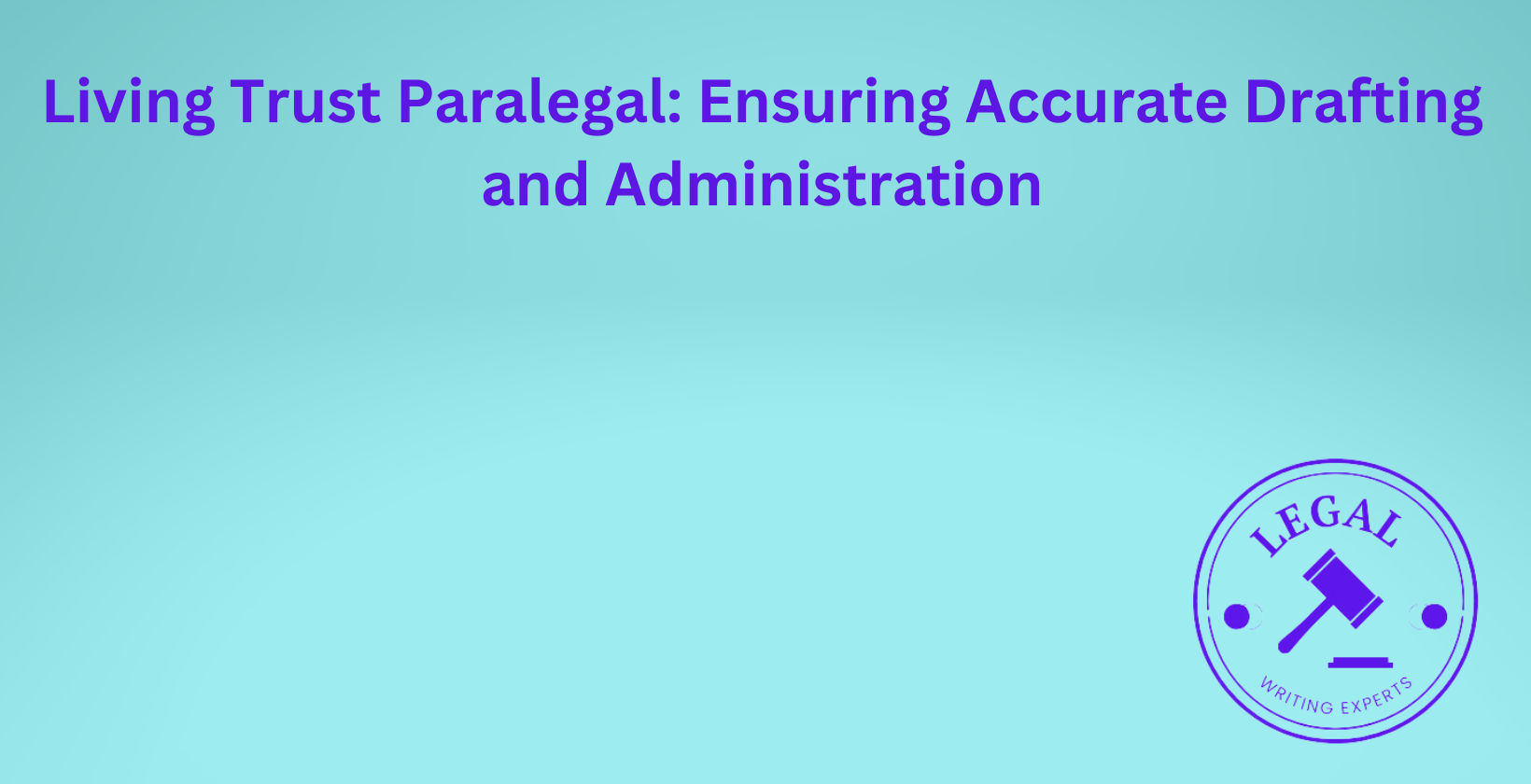Living Trust Paralegal: Ensuring Accurate Drafting and Administration
Written by
Jessica E
December 19, 2024 · 8 min read

A living trust is a crucial tool in estate planning, offering individuals a way to manage their assets effectively and ensure their wishes are followed after their passing or incapacitation. Paralegals play a significant role in assisting with the preparation and administration of living trusts, often providing cost-effective and efficient support to attorneys and clients. Understanding the functions of a living trust, its benefits, and the role of a paralegal can help individuals make informed decisions while avoiding common pitfalls in the drafting and management process.
What Is a Living Trust?
A living trust is a legal arrangement that allows individuals to place their assets into a trust during their lifetime for management and distribution. The person creating the trust, known as the grantor, appoints a trustee to oversee the trust’s assets according to specific terms. Living trusts can be revocable, allowing modifications during the grantor’s lifetime, or irrevocable, which cannot be altered once established.
How Does a Living Trust Work?
A living trust works by transferring legal ownership of assets to the trust, managed by the trustee. The grantor retains control and can modify the trust’s terms or dissolve it entirely in the case of a revocable trust. Upon the grantor’s death or incapacitation, the trustee ensures the assets are distributed according to the trust’s terms, bypassing the probate process.
What Are the Benefits of Establishing a Living Trust?
The benefits of establishing a living trust include avoiding probate, ensuring privacy, and providing clear instructions for asset management in case of incapacity. Living trusts allow for faster asset distribution and reduced legal fees compared to a will. They are particularly beneficial for individuals with complex estates or multiple beneficiaries.
Can a Paralegal Prepare a Living Trust?
Yes, a paralegal can assist in preparing a living trust under the supervision of an attorney. Paralegals can draft documents, gather necessary information, and provide administrative support. However, they cannot offer legal advice or act independently without attorney oversight.
What Are the Legal Limitations for Paralegals in Drafting Living Trusts?
The legal limitations for paralegals in drafting living trusts include prohibitions on giving legal advice, determining legal strategy, or signing documents on behalf of clients. Paralegals must work under the direction of a licensed attorney and cannot represent clients in legal proceedings.
How to Choose Between a Paralegal and an Attorney for Drafting a Living Trust?
To choose between a paralegal and an attorney for drafting a living trust, consider the complexity of your estate and legal needs. Attorneys provide comprehensive legal advice and representation, making them suitable for intricate trusts or disputes. Paralegals offer cost-effective drafting and administrative assistance under attorney supervision for straightforward trusts.
What Is the Process for Drafting a Living Trust with a Paralegal?
The process for drafting a living trust with a paralegal begins with collecting detailed information about the grantor’s assets, beneficiaries, and trustee preferences. The paralegal drafts the trust document using templates or attorney guidance, ensuring all legal requirements are met. An attorney reviews and finalizes the document before execution.
How to Ensure the Accuracy of a Living Trust Drafted by a Paralegal?
To ensure the accuracy of a living trust drafted by a paralegal, review the document thoroughly for completeness and alignment with your wishes. Confirm that all assets are listed, terms are clear, and legal formalities are followed. An attorney’s final review is essential for validating the trust’s legality.
What Are the Common Mistakes to Avoid When Creating a Living Trust?
Common mistakes to avoid when creating a living trust include omitting assets, failing to name alternate trustees, and neglecting to update the trust after major life changes. Ensure accurate titling of assets and consistent terms across all estate planning documents to avoid conflicts.
How to Fund a Living Trust After It Has Been Created?
To fund a living trust after it has been created, transfer ownership of assets such as real estate, bank accounts, and investments into the trust’s name. This involves updating titles, deeds, and beneficiary designations to reflect the trust as the new owner.
What Is the Role of a Paralegal in the Administration of a Living Trust?
The role of a paralegal in the administration of a living trust includes organizing documents, tracking asset distributions, and communicating with beneficiaries. Paralegals ensure administrative tasks are completed efficiently under the supervision of an attorney.
How to Amend or Revoke a Living Trust?
To amend or revoke a living trust, create a written document outlining the changes or the revocation, signed and notarized according to state law. Work with an attorney to ensure compliance with legal requirements and consistency across related documents.
What Are the Costs Associated with Creating a Living Trust Through a Paralegal?
The costs associated with creating a living trust through a paralegal vary but are generally lower than attorney fees. Costs typically range from $500 to $1,500, depending on the complexity of the trust and attorney involvement.
How to Find a Qualified Paralegal for Living Trust Services?
To find a qualified paralegal for living trust services, search for professionals with certification and experience in estate planning. Seek referrals from attorneys or use paralegal associations to verify credentials and expertise.
What Questions Should You Ask a Paralegal Before Hiring Them for Living Trust Preparation?
Questions to ask a paralegal before hiring them for living trust preparation include their level of experience, whether they work under attorney supervision, and their familiarity with state-specific trust laws. Confirm their ability to provide a clear cost estimate and timeline.
How to File a Living Trust After It Has Been Drafted?
To file a living trust after it has been drafted, execute the document with notarization and store it securely. Filing with a court is not necessary; however, record any real estate transfers associated with the trust.
What Are the Differences Between a Living Trust and a Will?
The differences between a living trust and a will include probate avoidance and timing of implementation. Living trusts take effect during the grantor’s lifetime, while wills only take effect after death. Trusts offer privacy, while wills become public record during probate.
How Does a Living Trust Avoid Probate?
A living trust avoids probate by transferring ownership of assets to the trust during the grantor’s lifetime. The trustee distributes the assets directly to beneficiaries, bypassing the court process.
What Assets Can Be Included in a Living Trust?
Assets that can be included in a living trust include real estate, bank accounts, investments, personal property, and business interests. Ensure all assets are properly titled in the trust’s name to include them effectively.
How to Update a Living Trust After Major Life Events?
To update a living trust after major life events, draft an amendment or restatement reflecting the changes. Significant events like marriage, divorce, births, or deaths necessitate updates to maintain accuracy and alignment with the grantor’s wishes.
Meet the Author
Distinguished linguist at Legal Writing Experts
Jessica is an expert legal writer with a remarkable blend of legal knowledge and linguistic precision. She earned her Juris Doctor degree from Duke University, where she attended on a prestigious Law Faculty Merit Scholarship. At Duke, Jessica demonstrated her exceptional abilities by serving as an editor of the Duke Law Review.
After graduating, Jessica further refined her skills during a two-year appellate clerkship at a distinguished law firm in North Carolina. Throughout law school, she enhanced her research and writing expertise as a research assistant and writer for various legal firms. Jessica’s deep understanding of legal language and meticulous attention to detail make her an invaluable asset to our legal writing services.


